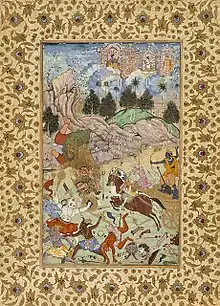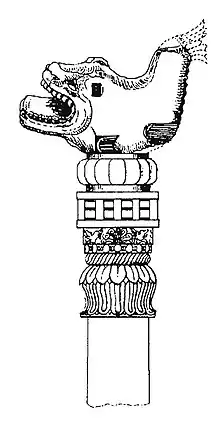Pradyumna
Pradyumna (Sanskrit: प्रद्युम्न) is the eldest son of the Hindu deities Krishna and Rukmini. Pradyumna is considered as one of the four vyuha avatars of Vishnu. According to the Bhagavata Purana (Canto 10, Chapter 55), Pradyumna was an incarnation of Kamadeva, the god of love, previously burnt by Lord Shiva's anger.
| Pradyumna | |
|---|---|
 Narada (left) and Krishna - Rukmini (right) welcome Pradyumna and Mayavati (centre). | |
| Affiliation | Avatar of Kamadeva |
| Personal information | |
| Parents | |
| Spouse | Mayavati, Rukmavati and Prabhavati |
| Children | Aniruddha |
| Vrishni heroes |
|---|
 |

The Harivamsa describes intricate relationships between the Vrishni heroes Krishna Vasudeva, Sankarsana, Pradyumna and Aniruddha, that would later form a Vaishnava concept of primary quadrupled expansion, or avatar.
Pradyumna is also a name of the Hindu god Vishnu. He is one in 24 Keshava Namas (names), praised in all pujas. It is also the only name in Sanskrit with all the 3 letters joint (referred as जोडाक्षर). धृष्टद्युम्न, dhṛṣṭadyumna also is of all joint letters.
Birth and early life

Pradyumna was son of Lord Krishna and 61st grandson of Adinarayan. His mother was Rukmini, whom Lord Krishna had abducted from Vidarbha on her invitation. Pradyumna was born in Dvaraka. He was the incarnate of the demigod Kamdeva. He had been burnt to ashes formerly by the anger of Lord Shiva.
According to the Bhagavata Purana, within a span of 10 days of Pradyumna's birth, he was abducted by the demon Shambara. He was then cast into the sea and swallowed by a fish. Under the protection of Lord Krishna, the fish was caught and purchased by Shambara. Pradyumna was found inside the fish and was raised by Mayavati, Sambara's cook and the incarnation of Rati, Kamadeva's wife. When Pradyumna grew up in a short while, Mayavati told him the truth about their identities. He battled the demon Sambara and killed him by severing Sambara's head with his sword.[1][2]
Marriages
Pradyumna's first wife was Mayavati, the incarnation of Kama's wife Rati. At first Pradyumna objected, but he was convinced when she told that she destined to marry him.[3] He also married the Rukmavati, the daughter of his father's brother in law, Rukmi. It is said that Rukmavati found his valor, handsomeness and charm beyond words and insisted on marrying him at her swayamvara. With her, he fathered, Krishna's grandson and favourite, also considered a vyuha avatar of Vishnu, Aniruddha. Prabhavati was an asura princess, she fell in love with Pradyumna and he eloped with her.[4]
Role in Dvarka

Soon after Pradyumna became a constant companion of his father Krishna and was well liked by the people of Dvaraka. Pradyumna was a mighty Maharathi warrior. He possessed the extremely rare Vaishnavastra which is the most powerful weapon in the universe. Also he was one of the very few people to know the secret of the Chakravyuha. According to Mahabharata, Pradyumna trained Abhimanyu and Upapandavas in warfare, when the Pandavas were in exile. But Pradyumna did not participate in the Kurukshetra War as he went on a pilgrimage with his uncle Balarama and other Yadavas.[5] But he was an active participant In Ashwamedha Yagna which was later conducted by Yudishthira.
Defending Dwarka
Pradyumna defended Dwarka against Shalva, the king of Salwa Kingdom, along with his father, uncle and brothers. In the Harivamsa, Pradyumna alone repelled the attack of Jarasandha.
Death
Pradyumna was later killed in an intoxicated brawl, along with all the other members of the Yadava dynasty. His grandson Vajra was the only survivor of the Yadu dynasty after this incident.[6]
Makaradhvaja

One of the epithets of Pradyuma in literature, such as in Harivamsa 99, is "Makaradhvaja", meaning "he whose banner or standard is the crocodile".[13] A pillar capital with the effigy of a Makara crocodile found at Besnagar near the Heliodorus pillar dedicated to Vasudeva, is also attributed to Pradyumna.[13] In Mahabarata too, the Makara is associated with Krishna's son and Kamadeva, the God of Love, suggesting they are identical.[13]
Descendants
As per the Bhagavata Purana, Canto 10, Chapter 61, Aniruddha was the son of Pradyumna and Rukmavati.[14] He was later abducted by Usha (daughter of Bana Daitya and granddaughter of Mahabali), who wished to marry him.[15] Usha's father, Banasura, however imprisoned Aniruddha, creating a battle between Lord Krishna and Lord Shiva. In the battle, Pradyumna defeated Shiva's son Kartikeya, who fled on his peacock. At the end of the war, Banasura lost and Aniruddha and Usha were married.[16] (See Canto 10, Chapter 62-63 of the Bhagavata Purana)
Aniruddha is said to have been very much like his grandfather Krishna, to the extent that some consider him to be a jana avatar, avatar of Vishnu. Aniruddha's son was Vajra. Vajra was known to be an invincible warrior and was the only survivor of the Yadu Dynasty after the Yadus' battle. According to some sources, Vajra then had 16 idols of Krishna and other gods carved from a rare, imperishable stone called Braja and built temples to house these idols in and around Mathura so as to feel the presence of Lord Krishna. It is said that Pradyumna and Arjuna were equivalent in their skills.
Texts
The Hindu version of the history of Pradyumna is mentioned in Bhagavata Purana (Canto 10, Chapters 55; Canto 11, Chapter 30).
The Jain version of the story of Pradyumna is mentioned in the Pradyumna-charitra (poem in 18 canons) of Rajchandra, written in 1878 AD.[17]
References
- Ph.D, Lavanya Vemsani (13 June 2016). Krishna in History, Thought, and Culture: An Encyclopedia of the Hindu Lord of Many Names: An Encyclopedia of the Hindu Lord of Many Names. ABC-CLIO. ISBN 978-1-61069-211-3.
- "Srimad Bhagavatam: Canto 10 - Chapter 55".
- Benton, Catherine (1 June 2006). God of Desire: Tales of Kamadeva in Sanskrit Story Literature. SUNY Press. ISBN 978-0-7914-6566-0.
- Ph.D, Lavanya Vemsani (13 June 2016). Krishna in History, Thought, and Culture: An Encyclopedia of the Hindu Lord of Many Names: An Encyclopedia of the Hindu Lord of Many Names. ABC-CLIO. ISBN 978-1-61069-211-3.
- Saraswati, Swami Vidyanand. Droupadi Ka Chirharan Aur Shrikrishan (in Hindi). Kitabghar Prakashan. ISBN 978-81-88118-64-9.
- "Srimad Bhagavatam: Canto 11 - Chapter 30".
- Indian History. Allied Publishers. 1988. p. A-222. ISBN 978-81-8424-568-4.
- Ayyar, Sulochana (1987). Costumes and Ornaments as Depicted in the Sculptures of Gwalior Museum. Mittal Publications. p. 13. ISBN 978-81-7099-002-4.
- Gupta, Vinay K. "Vrishnis in Ancient Literature and Art". Indology's Pulse Arts in Context, Doris Meth Srinivasan Festschrift Volume, Eds. Corinna Wessels Mevissen and Gerd Mevissen with Assistance of Vinay Kumar Gupta: 81.
- Austin, Christopher R. (2019). Pradyumna: Lover, Magician, and Scion of the Avatara. Oxford University Press. p. 24. ISBN 978-0-19-005412-0.
- VIENNOT, Odette (1958). "Le Makara dans la Décoration des Monuments de l'Inde Ancienne : Positions et Fonctions". Arts Asiatiques. 5 (3): 184. JSTOR 43484068.
- Visible in the back of the image entitled "Lion capital – Udayagiri – 5th century": "Gujari Mahal State Archaeological Museum – Gwalior". Kevin Standage. 15 April 2019.
- Austin, Christopher R. (2019). Pradyumna: Lover, Magician, and Son of the Avatara. Oxford University Press. p. 65. ISBN 978-0-19-005411-3.
- "Srimad Bhagavatam: Canto 10 - Chapter 61".
- "Srimad Bhagavatam: Canto 10 - Chapter 62".
- "Srimad Bhagavatam: Canto 10 - Chapter 63".
- Krishnamachariar 1989, p. 294.
Sources
- Krishnamachariar, M. (1989) [1937], History of Classical Sanskrit Literature, Motilal Banarsidass, ISBN 81-208-0284-5
External links
| Wikimedia Commons has media related to Pradyumna. |
